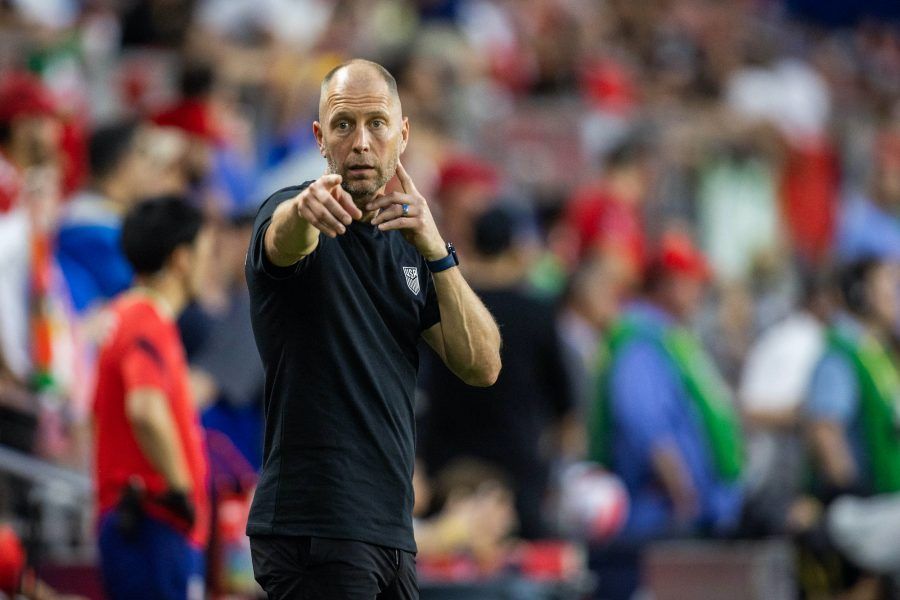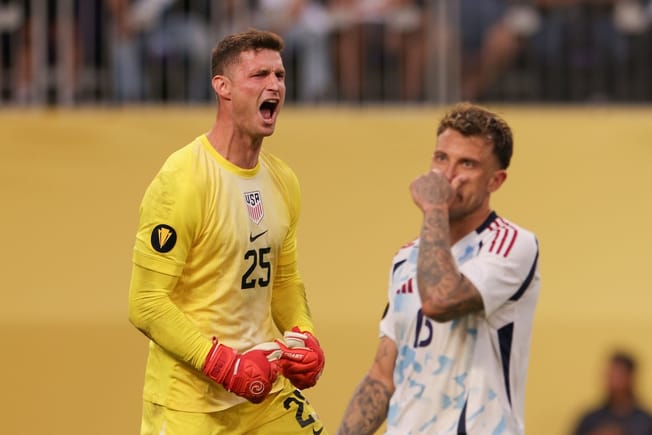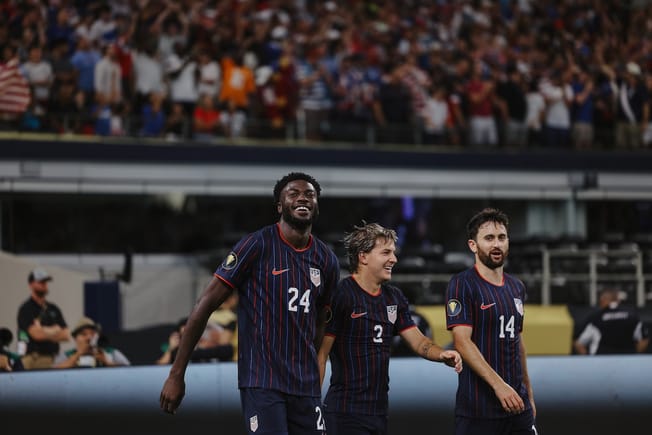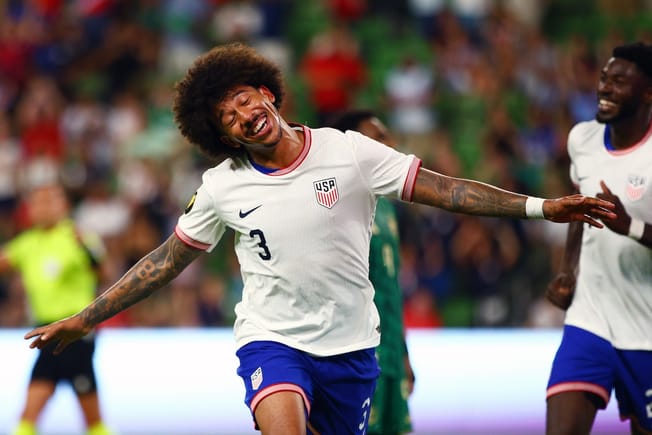180 minutes.
That’s all of the soccer that the U.S. men’s national team have left to play before they head to Qatar for the World Cup in November. Now that the June international window is over, the U.S. only have two games left – a pair of friendlies in September – before their first World Cup group stage game on November 21.
With so little time on the field in September and relatively little time leading up to those fall friendlies, the June window was always going to be the biggest opportunity to learn more about the USMNT before the World Cup.
So what did we learn about the USMNT from this month’s four games? Let’s get to some takeaways.
BERHALTER'S TACTICAL FLEXIBILITY
If I had to pick just one macro takeaway from this window, it would be Gregg Berhalter’s willingness to deviate from the 4-3-3 with a single pivot that we’ve seen so much from the U.S. since the start of 2020. We saw a bunch of different shapes and rotations from the USMNT in June.
There was that 3-2-5 possession shape that turned into a 4-3-3 press against Morocco. Then there was that slightly awkward 4-2-2-2 possession shape against Uruguay. The 4-3-3 popped back up again against Grenada, somewhat forgettably, before Berhalter went to a 4-2-3-1 and then a 3-5-2 against El Salvador.
Over the last four games, Berhalter has adjusted the USMNT’s shape at a rate that we just haven’t seen from him before. The tactical principles are still the same: the U.S. tries to break teams down with a mixture of possession and aggressive defensive pressure. But I think there is a ton of wisdom in Berhalter’s decision to move away from the single pivot and towards a more stable buildup shape.
Usually, that buildup shape featured a double pivot in midfield with Tyler Adams and Yunus Musah.
MUSAH'S VALUE
Speaking of Musah, he was one of the biggest beneficiaries of Berhalter’s choice to explore the double pivot this month. Instead of lining up as one of the dual No. 8s higher up the field, Musah had the chance to start plays closer to the backline. From there, he could get extra touches on the ball and take a chunk of the responsibility off of Adams in possession.
With his combination of press-resistance, speed, and strength, Musah is a great ball progresser. He regularly charged through the midfield and broke the opposition’s defensive shape in all three of the games that he played in June (vs. Morocco, vs. Uruguay, and at El Salvador).
He has work to do on the defensive side of his game and can improve his decision making, but Musah’s ability to move the ball forward is extremely valuable for the United States. Musah, along with Luca de la Torre, who has a similar set of skills, could help the USMNT break down some of the more defensive teams that they’ll face at the World Cup.
AARONSON IS ON THE CENTRAL MIDFIELD DEPTH CHART
Brenden Aaronson’s positioning in this window was another, at least partial, byproduct of Berhalter’s tactical tinkering. Aaronson, who mostly played as a winger for the U.S. before this camp, played in central midfield – in one form or another – in all four of the USMNT’s most recent games.
Against Morocco, Aaronson defended as a No. 8 but camped out in the right halfspace in possession, like Berhalter’s wingers normally do. Against Uruguay, he came on at halftime and played as a No. 8. Against Grenada, Aaronson stepped in for de la Torre in central midfield in the second half.
Finally, against El Salvador, Aaronson pressed some as a central midfielder and played a few minutes as a No. 10 (although he spent most of his time in possession in the left halfspace).
Aaronson isn’t a perfect central midfield player. But adding him to the central midfield depth chart and using him in a hybrid No. 8/halfspace role gives the U.S. another level of personnel and tactical flexibility. That can really only be a good thing as the fall gets closer.
NATIONAL LEAGUE GAMES WEREN’T GOOD WORLD CUP PREP
Look, I said that this June window was a big opportunity to learn about the U.S. ahead of November. I didn’t say it was a perfect opportunity. The USMNT’s first two games of the window were friendlies against quality opponents (Morocco and Uruguay). Their second two games of the window, though, were group stage matches at home against Grenada and on the road against El Salvador in the Concacaf Nations League.
We gained new information after every game, but the quality and the quantity of that information took a major hit from the friendlies to the Nations League games. It’s hard to draw conclusions about a team after a game against Grenada, the 170th team in the FIFA rankings. It’s also hard to draw conclusions about a team after a game against El Salvador that was played on a field that looked like this…
And that made the players look like this…
Good night, America. pic.twitter.com/XfzEdXWYY8
— U.S. Men's National Soccer Team (@USMNT) June 15, 2022
There wasn’t anything that the U.S. could do about the timing of these Nations League games. Still, they didn’t do a lot to prepare the USMNT for the World Cup and that’s an unfortunate thing.
QUESTIONS ABOUT FULLBACK DEPTH
This U.S. team misses Sergino Dest. They really do. Without Dest, who couldn’t play in this window due to an injury, the U.S. struggled to use their fullbacks in meaningful ways in the attack.
Instead of trying to use either Reggie Cannon or DeAndre Yedlin to replace Dest’s production on the right wing, Berhalter used Cannon as a right-sided center back and let Tim Weah occupy the right wing in the first game of the window.

In the second game of the window, neither Joe Scally nor Yedlin looked like reliable options in the attack. George Bello doesn’t appear to be the answer at backup left back and Cannon didn’t impress when he was asked to do something of a Dest impression against Grenada or in the first half against El Salvador on Tuesday evening. After this four-game window, I still don’t know who is the best option to deputize for Jedi Robinson on the left side. I also don’t know exactly what the right back depth chart looks like after Dest.
In a weird way, though, that lack of clarity with the right back depth chart has actually given me some clarity.
If Dest is out, either due to injury or lineup rotation in September or at the World Cup, I’d like to see more of that fluid three-at-the-back shape in possession. I’m talking about the one where the right back becomes a right-sided center back in possession and the winger provides the width. At this point, it seems clear that Cannon and Yedlin aren’t going to be world-beaters in the attack. So why not keep the right back deeper and let the natural creators have more say in the attack?
I hope we see more of the 4-3-3 press that shifts into a back three in possession. My gut says that if Dest is out in a big game, we will.
A CB SPOT IS STILL UP FOR GRABS
This one is simple. I don’t think any of Aaron Long, Cameron Carter-Vickers, or Erik Palmer-Brown claimed that second center back spot next to Walker Zimmerman. None of those three players truly wowed in this window. Long’s passing is limited and he had some spacey defensive moments. CCV wasn’t convincing in the air. EPB barely played because of a hamstring injury.
Now, if the World Cup started yesterday, I’m pretty sure that Long would start next to Zimmerman in the middle of the U.S. backline. It seems pretty clear that Long has the inside track over CCV and EPB in Berhalter’s mind. Where does Chris Richards factor in, though?
As far as I’m concerned, Richards might be one of the biggest winners of the entire June window – and he didn’t even set foot in camp for the U.S. due to an injury. Because none of the center backs that Berhalter brought in to audition for the role of Zimmerman’s partner thrived in June, Richards should have every chance to claim that spot in September.
FERREIRA IS THE ONLY WORLD CUP LOCK UP TOP
Given the minutes distribution during the June window and his ability to find good spots in the attack, Jesus Ferreira is a lock for the U.S.’s World Cup roster. That was pretty much true before June, but it’s definitely true now. Ferreira started three of the four June games for the U.S. and played significant minutes in all four.
If he’s healthy, Ferreira will be in Qatar.
The picture is murkier for the rest of the No. 9s in the player pool. It doesn’t look like Haji Wright, who was the only other striker in camp with the U.S., impressed Berhalter, who wasn’t pleased with Wright’s performance against El Salvador and subbed him off at halftime on Tuesday.
Will another striker step up and earn a look in September? Time will tell, though there’s precious little of it left before the World Cup.







Comments